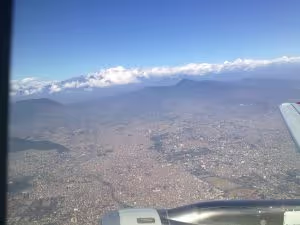Planning and Preparedness in Kathmandu

I am writing this as the plane begins its climb up above the peaks of the Himalayas and the immense city of Kathmandu shrinks beneath us. But I’ve been hearing this week about how this beautiful city might be devastated in the event of a major earthquake. Worryingly, Kathmandu is high on the list of major cities that are predicted to suffer a large earthquake.
Motivation’s emergency wheelchair project is a part of a larger collaboration between Motivation and Handicap International, and this week my colleague, Francesca Garton, and I have been visiting their team in Nepal in order to test a package of tools we have developed to assist in planning of wheelchair programmes.
One element of this package is a guide for wheelchair service setup as part of a response to an emergency. The Handicap International team were able to give some feedback as they are part of a consortium of organisations in Nepal working together to try to improve the capacity of health and rehabilitation services to prepare for and respond to a major earthquake.
In the event of a major earthquake hitting the city there would be large numbers of casualties and preparation is already underway to prepare hospitals to respond immediately before international help arrives, and subsequently to begin rehabilitating injured people.
Many of these injured would need to use a wheelchair, and our emergency wheelchair programme aims to assist these people. As well as the actual wheelchair, Motivation has developed a series of documents which will guide the setup of the wheelchair service in an emergency, in line with WHO wheelchair provision guidelines.
After a natural disaster people who need wheelchairs fall into two categories – temporary users with short term injuries, and those who will need a wheelchair permanently; either as a result of a severe injury or losing their previous wheelchair during the emergency. The emergency response would need to serve both of these groups, following up those with permanent disabilities after the initial response is complete.

The wheelchair service package we have developed includes instructions on the facilities, equipment and staff needed within a service. A simple assessment and prescription form has been prepared, alongside user training material that includes wheelchair mobility and healthcare information.
This week I was able to talk through these documents with Handicap International and see where improvements were needed. The team in Nepal were keen to have them as soon as they are finished so that they can use them as part of their emergency preparedness work and understand what would be required to set up an appropriate wheelchair response in the event of a major earthquake hitting Kathmandu.
It’s so encouraging to see disabled people being included in planning for disaster response; they are an extremely vulnerable group in an emergency. Of course the underlying hope is that none of this will be necessary, but in case it is, there is team in Nepal who are committed to learning lessons from the past to ensure that future disaster responses are as efficient and robust as they can be.
Sarah Sheldon - Programme Coordinator, Motivation
Stay updated
Sign up for our newsletter to receive regular updates on resources, news, and insights like this. Don’t miss out on important information that can help you stay informed and engaged.
Related articles
.png)


Explore Elrha
Learn more about our mission, the organisations we support, and the resources we provide to drive research and innovation in humanitarian response.